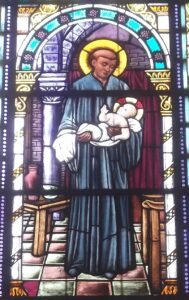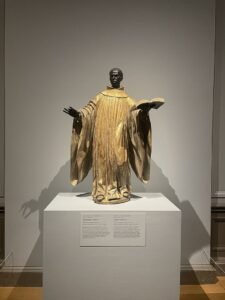St Benedict the Moor: 13 Facts about His Legacy Of Selfless Service That Changed Lives Forever
St Benedict the Moor went from slave to Franciscan friar. St Benedict the Moor pushed through racial boundaries and continues to show the world how loving Christ in the Holy Eucharist can transcend race and economic status to show the world hope, faith, and love, and unity.

Who was St. Benedict the Moor?
St Benedict the Moor, also known as St. Benedict the Black and St. Benedict the African, was born in San Fratello, a town in Sicily, Italy, around 1526. His parents were African slaves who were brought to Italy by their owners. As a child, St Benedict the Moor was also enslaved, and he worked as a shepherd for most of his youth.
At the Santa Maria di Gesù Franciscan Friary in Palermo, Sicily, St Benedict the Moor joined the Franciscan Order as a lay brother when he was about 18 years old.
He worked as a chef, porter, and gardener for the rest of his life, serving the Church and the neighborhood. St Benedict the Moor was renowned for his unwavering piety and modesty.
He was supposed to love prayer and meditation very much and to spend a lot of time in thought.
It was stated that he would spend hours praying in front of the Holy Sacrament because of his love to the Communion.
Why was St. Benedict called a Moor?
The term “Moor” was used in medieval Europe to refer to people of African descent. It is believed that St Benedict the Moor was called “the Moor” because of his dark complexion and his African ancestry.
St Benedict the Moor was admired for his sanctity and unwavering devotion to God despite the racism and discrimination he experienced during his lifetime.
His feast day is April 4, and Pope Pius VII declared him a saint in 1807.
The life of St Benedict the Moor is an example to us all.
He overcame the obstacles in his life to live a life of commitment to God and service.
His example demonstrates to us that no matter what difficulties we may face, we may always look to God for support and guidance.
Where was St. Benedict the Moor from?
St Benedict the Moor was born in San Fratello, a small town in the province of Messina, Sicily. Due to its popularity as a travel destination for international traders and sailors at the time, San Fratello served as a cultural melting pot. It is said that Benedict’s parents were African slaves who were brought to San Fratello by their owners.
Growing up in a town with such diverse cultural influences must have had an impact on St Benedict the Moor, as he went on to lead a life that transcended racial boundaries and cultural differences.
What is interesting about St. Benedict the Moor?
St Benedict the Moor is his deep sense of humility and devotion to service.
Despite all of his successes, he never lost his humility and considered himself as God’s and others’ servant. St Benedict the Moor was renowned for his steadfast devotion to prayer and great faith.
It is believed that he had a deep passion for the Eucharist and would spend hours in meditation and contemplation.
The numerous miracles attributed to St Benedict the Moor are just another remarkable part of his life.
Many tales claim that in his presence, exorcisms, miraculous healings, and other paranormal occurrences occurred.
St Benedict the Moor’s ability to cross racial and cultural barriers is arguably one of his most amazing qualities. He was a man of African descent living in Italy during a time of great racial prejudice and discrimination. Yet he was able to rise above these barriers and become a revered figure in both the African and European communities.
What did Saint Benedict the Moor do?
St Benedict the Moor spent most of his life serving the Franciscan friary of Santa Maria di Gesù in Palermo, Sicily.
He was well known for his great devotion to God and his constant commitment to prayer and meditation. St Benedict the Moor spent a lot of time serving his society in addition to pursuing his spiritual interests.
While employed at the friary as a chef, porter, and gardener, he was noted for his kindness and compassion toward everyone he came into touch with.
St Benedict the Moor also had a reputation for performing miracles. There are many accounts of people being healed and saved from various afflictions through his intercession.
Saint Benedict’s contribution to racial and ethnic harmony was perhaps one of his most significant accomplishments. He was able to shatter preconceived notions about race and gained popularity among both African and European people.
Where is Saint Benedict the Moor buried?
St Benedict the Moor was laid to rest in Palermo’s Church of St. Mary of Jesus following his death in 1589. His tomb soon became a popular destination for pilgrims seeking healing and spiritual guidance.
Over time, the church fell into disrepair, and Saint Benedict’s tomb was lost. However, in 1989, the church was restored, and Saint Benedict’s tomb was rediscovered. Today, his remains are housed in a beautiful silver casket in the Church of St. Mary of Jesus, where they continue to inspire visitors from around the world.
How do I make a pilgrimage to see St Benedict the Moor?
The first step in making a pilgrimage to see St Benedict the Moor is to decide where you would like to go.
The Church of St. Mary of Jesus in Palermo, Sicily is home to Saint Benedict’s tomb, as I reported in an earlier blog article.
Planning your journey comes next after choosing your destination.
You must make transportation arrangements to Palermo if you are coming from outside of Italy.
You can go by bus, train, or airplane. You may see Saint Benedict’s tomb in Palermo’s Church of St. Mary of Jesus once you get there.
There is no entrance fee and the church is always available to guests.
You might spend some time expressing your prayers and gratitude for Saint Benedict’s life and legacy when you visit his grave.
You can also light a candle or leave a small offering as a symbol of your devotion.

I absolutely adore traveling and traveling to see the saints makes life that much more rich with meaning! One thing I always do, if possible, when I’m visiting a new place is to go on a Red Bus Tour.
These tours take you to the best site seeing places for that city for super cheap. So, if you’re on a budget and want to even skip the car rental, as long as your hotel is in walking distance to one of the pick up and drop off sites for the bus, you’re good to go!
I’ve found a Red Bus Tour for you to do in Palermo, Italy, when you go on your pilgrimage to see St Benedict the African! Just click HERE to see the details or click on the picture below.

What other saints are buried in Southern Italy?
In addition to St Benedict the Moor, there are many other saints who are buried in Southern Italy. Here are a few examples:
- Saint Lucy – Saint Lucy was a Christian martyr who was born in Syracuse, Sicily. Her tomb is located in the Church of Santa Lucia al Sepolcro in Syracuse.
- The patron saint of Palermo is called Saint Rosalia.
Her grave can be found in Palermo’s Sanctuary of Saint Rosalia on Mount Pellegrino. - Saint Nicholas, “Santa Claus”, as many like to refer to him as, is one of the most famous saints in the world. His tomb is located in the Basilica di San Nicola in Bari, Puglia.
- Saint Gerard Majella – Saint Gerard Majella was a Redemptorist lay brother who was known for his gift of miracles. His tomb is located in the Church of Saint Gerard in Materdomini, Campania.
Making a pilgrimage to see St Benedict the Moor is a wonderful way to deepen your spiritual practice and connect with the rich history of Southern Italy. Whether you are visiting Saint Benedict’s tomb or the burial places of other saints, may your journey be filled with peace, inspiration, and blessings.
What else is there to see in Southern Italy near Gangi?
Gangi is a beautiful hilltop town in the Province of Palermo, Sicily. If you are visiting Gangi to see Saint Benedict the Moor’s birthplace, there are several other nearby attractions that you might want to check out. Here are a few examples:
- The Madonie Mountains – The Madonie Mountains are a stunning range of mountains that are located just south of Gangi. They offer opportunities for hiking, wildlife viewing, and scenic drives.
- The Santuario di Gibilmanna – The Santuario di Gibilmanna is a sanctuary that is located on Mount Pellegrino near Palermo. It is noted for its magnificent frescoes and is a popular pilgrimage site.
- The Aeolian Islands are a group of volcanic islands located off the coast of Sicily.
- They are renowned for their rough terrain, pristine seas, and quaint settlements.
- The Sicilian city of The Valley of the Temples is recognized by UNESCO as a World Heritage Site.
It is a must-see for history buffs because it is home to several excellently preserved ancient Greek temples.
What is Saint Benedict the Moor patron saint of?
The patron saint of African Americans, persons of color, and those who are shunned by society is Saint Benedict the Moor.
He is also honored as the patron saint of Sicily’s Palermo, where he lived for the majority of his life.
St Benedict the Moor was born to African parents who were enslaved in Sicily.
Despite facing discrimination and hardship throughout his life, he maintained a deep faith and a commitment to helping others. He became a lay brother in the Franciscan order and dedicated himself to serving the poor and the sick.
Today, St Benedict the Moor is remembered as a model of perseverance, compassion, and love. People from all walks of life are still motivated by his legacy to fight for justice and build a more fair and just society.
A stunning and interesting location, southern Italy is rich in history, spirituality, and scenic beauty. Whether you are visiting Gangi to see St Benedict the Moor’s birthplace, or exploring the nearby attractions, may your journey be filled with joy, wonder, and blessings.
What is the prayer for St. Benedict the Moor?
The prayer for St Benedict the Moor is a simple and powerful way to invoke his intercession and seek his help in times of need. Here is the text of the prayer:
“O God, who didst wonderfully join in thy servant St Benedict the Moor a passion for thy Name and a love of thy people; grant unto us, we beseech thee, that same fervor of spirit, that we may be found like him in deed and in truth. Through Christ our Lord. Amen.”
This prayer can be chanted at any time, but it is most effective when recited during trying, stressful, or uncertain circumstances. It is a beautiful reminder of St Benedict the Moor’s unwavering faith and commitment to serving others, and can inspire us to follow in his footsteps.
What is a Novena to St Benedict the Moor that I can pray?
A novena is a nine-day prayer devotion that is often used to ask for the intercession of a particular saint. Here is a beautiful novena to St Benedict the Moor that you can use to deepen your connection with his spirit and seek his help and guidance:
Day 1: Begin the novena by asking St Benedict the Moor to intercede for you and to guide you in your journey towards greater faith and love.
Day 2: Pray for St Benedict the Moor’s intercession in your personal life, asking him to help you overcome any obstacles and to deepen your sense of purpose and meaning.
Day 3: Ask St Benedict the Moor to intercede for your family and loved ones, praying for their health, happiness, and well-being.
Day 4: Pray for St Benedict the Moor’s intercession in your community, asking him to inspire you to be a force for good and to help those in need.
Day 5: Ask St Benedict the Moor to intercede for the Church, praying for unity, healing, and renewal.
Day 6: Pray for St Benedict the Moor’s intercession in the world, asking him to help bring peace, justice, and compassion to all people.
Day 7: Ask St Benedict the Moor to intercede for those who are marginalized or oppressed, praying for their liberation and empowerment.
Day 8: Pray for St Benedict the Moor’s intercession in your spiritual life, asking him to help you grow in holiness and to deepen your relationship with God.
Day 9: Conclude the novena by thanking St Benedict the Moor for his intercession and asking him to continue to guide and inspire you in all aspects of your life.
In conclusion, St Benedict the Moor is a powerful intercessor and spiritual guide who can help us deepen our faith, find strength in times of trial, and become more compassionate and loving people. Whether you choose to recite the prayer for St Benedict the Moor or to undertake a novena in his honor, may your prayers be filled with grace, peace, and blessings.

How can Saint Benedict the Moor help me become a saint?
- By his example of humility and service.
One of the key qualities of sainthood is humility, which means putting others before oneself and accepting one’s own limits and imperfections.
In St Benedict the Moor’s life, this virtue is exemplified to perfection.
Even though he experienced unfairness and discrimination, he never allowed it stop him from pursuing his goal of serving others and loving his neighbors as himself.
We might learn to build an attitude of humility in our own lives by imitating him.
- By his commitment to prayer and contemplation.
St Benedict the Moor was known for his deep prayer life and his commitment to contemplation. He spent hours in prayer each day, seeking to deepen his relationship with God and to discern His will. We can learn from him and develop a closer relationship with God by making time in our own life for prayer and reflection.
- By his devotion to the Eucharist.
St Benedict the Moor had a deep love for the Eucharist and saw it as the source and summit of his spiritual life. He frequently adored the Holy Sacrament for extended periods of time.
We can feel the transforming force of Christ’s presence in our lives by imitating his example and strengthening our own devotion to the Eucharist.
- By his commitment to serving the poor and sick.
Finally, Saint Benedict the Moor’s life was marked by a deep commitment to serving those in need. He would often visit the sick and dying, bringing them comfort and healing. By following his example and serving those in need in our own communities, we can grow in compassion and love, and become more like Christ.
St Benedict the Moor is a powerful intercessor and guide on our journey towards sainthood. We might become more holy and more fully embrace the life God has called us to through imitating his example of humility, prayer, devotion to the Eucharist, and service to others.
May Saint Benedict the Moor’s example and intercession inspire us to become the saints God created us to be.
Are You Inspired?
Did today’s lessons provide you with any inspiration? I genuinely appreciate studying and discussing the lives of the saints.
If you wear the gorgeous shirt I designed just for you, you can recount the story of St Benedict the Moor.
Wearing these t-shirts makes it simpler to discuss saints with close friends, family, and random strangers. You may now tell everyone who compliments your shirt or inquires about it about St Benedict the Moor in addition to describing the background of the famous paintings and sculptures.
They might go to church with you so you can spread the good news there. You may talk about how everybody needs a savior, how Jesus is the ideal sacrifice made to pay the price for our sins, and how everyone is dependent on him.
Enrolling them in your parish’s RCIA programs would be far more beneficial.
You may rely on me to consider you before I take any action.
To view the shirt design, simply click the image or go HERE. To access the checkout page after choosing your preferred size and color, click the PURCHASE NOW button.

For more great saints, visit our blog HERE.
Have a few more minutes to dive into another saint?
Why not learn about:
- The Annunciation to Mary: 9 Cataclysmic Facts how Faith and Surrender Changed the World
- 10 Facts Unveiling the Beauty of “The Annunciation Triptych”: A Masterpiece of Renaissance Art
- St. Patrick: 14 Awe-inspiring Aspects about his Life and Legacy
- St. Louise de Marillac: 15 Inspiring & Unknown Facts on her Life
Have you thought about coming along every day to learn more about the Saint of the Day? If you would like to receive my daily saint emails in your inbox, kindly take a moment to join up. I’ll keep it short since I know you’ve got a lot on your plate, but I truly want to tell you more so you can learn from my experience and develop into a warrior like me.
As a special gift, I’ll also give you a free screensaver for your phone. After you submit the form, I’ll send you the link to download the updated screensaver. Enjoy!
Well, that’s all for today.
I’ll see you back tomorrow with another Saint of the Day to inspire you!
God bless you,
-Priscilla


